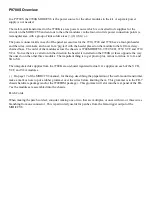
Sauter Italia S.p.A. • Code 104RDB901A10SAU
RDB900F901
CANbus user interfaces, with LCD graphic display
version 1.0
3.2
Installation
Installation is:
- by panel, with black frontal plate and gasket (included)
- by back-panel, with double-sided tape (included).
3.3
Additional information for installation
• working conditions (working temperature, humidity, etc.) must be
between the limits indicated in the technical data
• do not install the instrument close to heating sources (heaters, hot air
ducts, etc.), devices provided with big magnetos (big speakers, etc.),
locations subject to direct sunlight, rain, humidity, dust, mechanical
vibrations or bumps
• according to the safety legislation, the protection against electrical
parts must be ensured by a correct installation of the instrument; the
parts that ensure the protection must be installed so that you can not
remove them if not by using a tool.
4
ELECTRICAL CONNECTION
4.1
Electrical connection
Position micro-switch 4 on position ON to plug in the termination of
the CAN port; micro-switches 1, 2 and 3 are reserved.
Connector 1:
CAN port.
PIN
MEANING
1
ground
2
signal -
3
Also look at the baud rate of the CAN port of the controller.
Connector 2:
power supply (24 VAC/DC non isolated).
PIN
MEANING
4
power supply
5
power supply
GB
ENGLISH
1
GETTING STARTED
1.1
Important
Read these instructions carefully before installing and using the instrument and follow all additional information for installation and electrical connection; keep these instructions close to the instrument for future
consultations.
The instrument must be disposed according to the local legislation about the collection for electrical and electronic equipment.
2
INTRODUCTION
2.1
Introduction
RDB900 is a family of user interfaces that support the CAN bus.
The devices can be used with the controllers of the family RDT900; the user interface loads the pages of the controller and refreshes the value of the shown variables with "browser" technology.
The user interface is made of a 128 x 64 pixel single colour LCD graphic display (black with rearlighting through white LED) and a 6 buttons (with preset functions) membrane keyboard.
The instruments has the alarm buzzer.
Mounting is:
• by panel, with black frontal plate and gasket (included)
• by back-panel, with double-sided tape (included).
3
SIZE AND INSTALLATION
3.1
Size
Size in mm (in).
4.2
Additional information for electrical connection
• do not operate on the terminal blocks with electrical or pneumatic
screwers
• if the instrument has been moved from a cold location to a warm
one, the humidity could condense on the inside; wait about an hour
before supplying it
• test the working power supply voltage, working electrical frequency
and working electrical power of the instrument; they must corre-
spond with the local power supply
• connect the user interface to the controller using a twisted pair
• disconnect the local power supply before servicing the instrument
• do not use the instrument as safety device
• for repairs and information on the instrument please contact Sauter
sales network.
5
TECHNICAL DATA
5.1
Technical data
Purpose of control:
user interface for programmable controllers.
Construction of control:
electronic device to be incorporated.
Box:
self-extinguishing black.
Size:
128.0 x 94.5 x 30.7 mm (5.039 x 3.720 x 1.208 in).
Size refers to the instrument with connector 1 and connector 2 prop-
erly plugged.
Installation:
installation is:
• by panel, with black frontal plate and gasket (included)
• by back-panel, with double-sided tape (included).
Frontal protection:
IP40 (IP65 for panel mounting with gasket, this
last included).
Connections:
extractable male + female terminal blocks (power sup-
ply and CAN port), 6 poles telephone connector (programming port).
The maximum length of the connecting cables depends on the baud
rate of the CAN port of the controller:
• 1,000 m (3,280 ft) with baud rate 20,000 baud
• 500 m (1,640 ft) with baud rate 50,000 baud
• 250 m (820 ft) with baud rate 125,000 baud
• 50 m (164 ft) with baud rate 500,000 baud.
The user interface recognizes the local CAN port baud rate of the con-
troller automatically.
Working temperature:
from 0 to 50
°
C (32 to 120
°
F, 10 ... 90% of
relative humidity without condensate).
Pollution situation:
2 or more.
Power supply:
24 VAC (min. 20.4 VAC, max. 27.6 VAC), 50/60 Hz,
3 VA (approximate) non isolated or 20 ... 40 VDC, 2 W (approximate)
non isolated, supplied from a class 2 circuit.
Protect the power supply with an UL listed or recognized fuse rated:
• 80 mA-T if the user interface is powered with 15... 40 VDC
• 160 mA-T if the user interface is powered with 12... 19 VAC
• 125 mA-T if the user interface is powered with 19... 24 VAC.
Overvoltage category:
III.
Alarm buzzer:
incorporated.
Display:
128 x 64 pixel single colour LCD graphic display (black with
rearlighting through white LED).
Communication ports:
1 non optoisolated CAN port.
I
ITALIANO
1
IMPORTANTE
1.1
Importante
Leggere attentamente queste istruzioni prima dell’installazione e prima
dell’uso e seguire tutte le avvertenze per l’installazione e per il collega-
mento elettrico; conservare queste istruzioni con lo strumento per con-
sultazioni future.
Lo strumento deve essere smaltito secondo le normative
locali in merito alla raccolta delle apparecchiature elettriche
ed elettroniche.
2
INTRODUZIONE
2.1
Introduzione
RDB900 è una famiglia di interfacce utente che supportano il bus CAN.
I dispositivi possono essere utilizzati con i controllori della famiglia
RDT900; l’interfaccia utente carica le pagine del controllore e rinfresca
il valore delle variabili visualizzate con una tecnologia tipo “browser”.
L’interfaccia utente è composta da un visualizzatore grafico LCD mono-
colore (nero con retroilluminazione a LED bianchi) da 128 x 64 pixel e
da una tastiera a membrana a 6 tasti (con funzioni predefinite).
Gli strumenti dispongono buzzer di allarme.
L’installazione è prevista:
• a pannello, con placca frontale nera e guarnizione (incluse)
• a retro pannello, con biadesivo (incluso).
3
DIMENSIONI E INSTALLAZIONE
3.1
Dimensioni
Si veda il disegno della sezione in Inglese.
Le dimensioni sono espresse in mm (in).
3.2
Installazione
L’installazione è prevista:
• a pannello, con placca frontale nera e guarnizione (incluse)
• a retro pannello, con biadesivo (incluso).
3.3
Avvertenze per l’installazione
• accertarsi che le condizioni di lavoro (temperatura di impiego, umidi-
tà, ecc.) rientrino nei limiti indicati nei dati tecnici
• non installare lo strumento in prossimità di fonti di calore (resistenze,
condotti dell’aria calda, ecc.), di apparecchi con forti magneti (grossi
diffusori, ecc.), di luoghi soggetti alla luce solare diretta, pioggia,
umidità, polvere eccessiva, vibrazioni meccaniche o scosse
• in conformità alle normative sulla sicurezza, la protezione contro even-
tuali contatti con le parti elettriche deve essere assicurata mediante
una corretta installazione dello strumento; tutte le parti che assicura-
no la protezione devono essere fissate in modo tale da non poter
essere rimosse senza l’aiuto di un utensile.




















